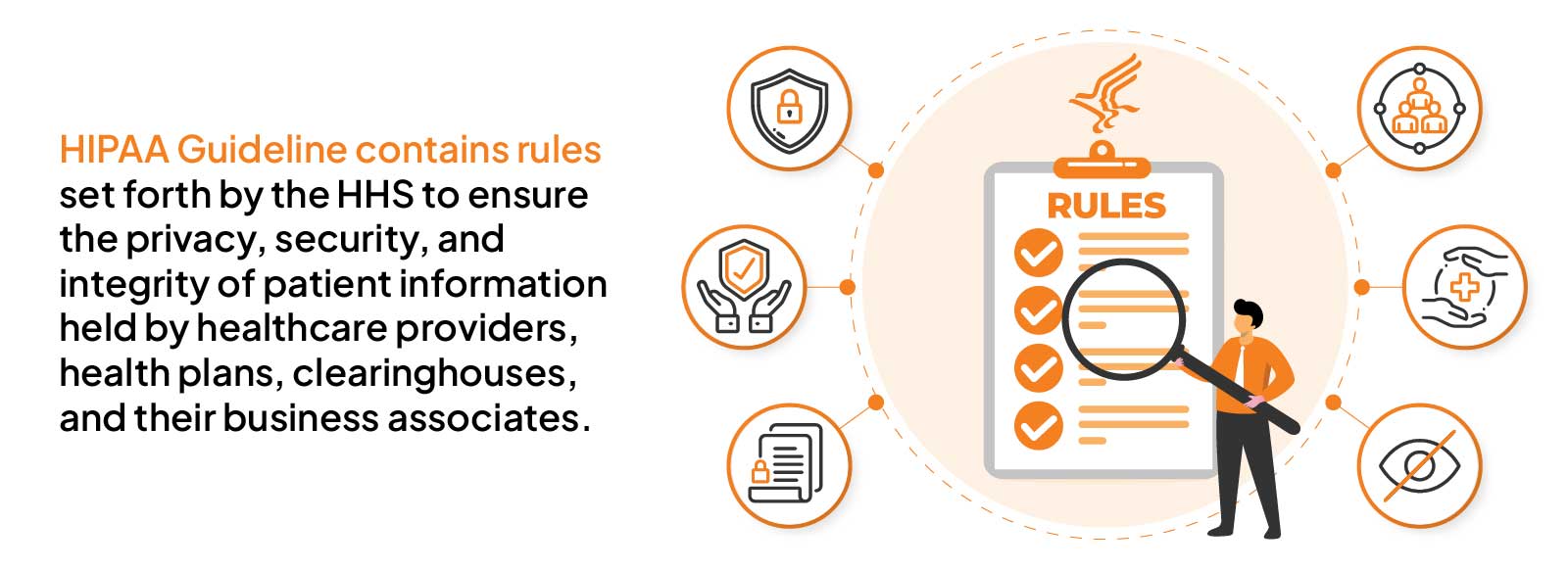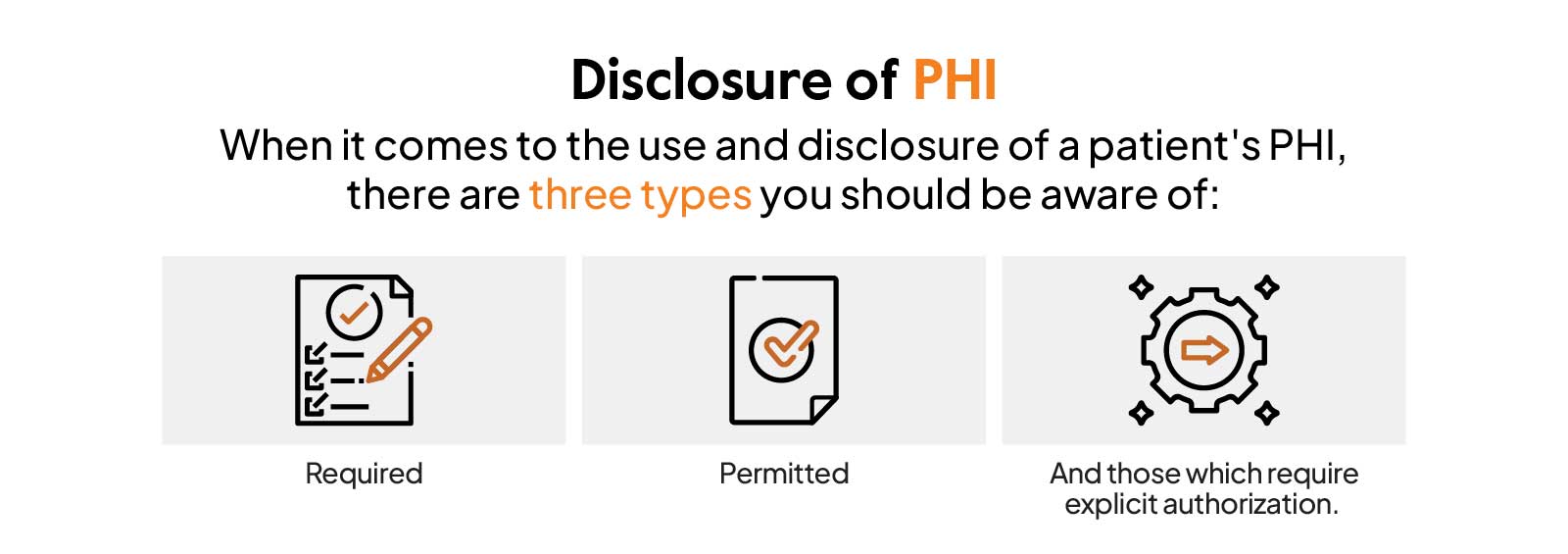HIPAA Guidelines: How to Keep Your Patients’ Data Safe
Meeba Gracy
Feb 26, 2024

At the very core of the medical practice is the trust between a patient and their physician. To protect this fragile relationship, healthcare organizations need to understand HIPAA Guidelines and how they should be applied when handling patients’ personal data.
In this blog post, we discuss the main HIPAA guidelines and why adhering to them is critical for protecting Protected Health Information (PHI).
Read on to learn what you need to know!
What are HIPAA Guidelines?
HIPAA (Health Insurance Portability and Accountability Act) is a US federal law passed by the United States Department of Health & Human Services in 1996 to safeguard sensitive, personal patient data from being exposed.
HIPAA Guideline pdf contains rules set forth by the HHS to ensure the privacy, security, and integrity of patient information held by healthcare providers, health plans, clearinghouses, and their business associates.
- The HIPAA Privacy Rule provides a necessary layer of protection for personal health information, setting stringent standards, and safeguards to preserve its privacy. Moreover, the use and disclosure of this confidential data can only happen under specific conditions with the patient’s knowledge.
- The Security Rule requires the health care organization to maintain reasonable technical, administrative, and physical safeguards to protect ePHI from various threats.
- The Breach Notification Rule requires covered entities to notify affected individuals of breaches in unsecured protected health information.

Hence, following HIPAA guidelines is a must to guarantee that the PHI stays secure and can’t be taken advantage of.
Also read: Guide on HIPAA enforcement rule
List of HIPAA Privacy Guidelines
Before anything else, let’s understand what HIPAA privacy rules are:
The Privacy Rule safeguards and defends the PHI of any person. It puts boundaries and restrictions in place on how this data can be used or revealed without permission from the patient first. This rule protects people’s health records at all times.
All companies which handle such data, referred to as covered entities, must follow these basic standards. This includes health care plans, providers, and subsidiaries who need to share PHI.
Now let’s take a look at different guidelines that come under these!
When it comes to the use and disclosure of a patient’s PHI, there are three types you should be aware of: required, permitted, and those which require explicit authorization.

Disclosure of PHI
When it comes to the use and disclosure of a patient’s PHI, there are three types you should be aware of. This includes
- Required
- Permitted
- And those which require explicit authorization
Remember that any applicable permit may come with conditions. If it doesn’t align with an individual’s wishes, they can object or request restrictions on who their PHI is shared with at any time.
As a further safeguard, patients have the right to ask for an “accounting of disclosures.”
Now, remember that there is a delicate balance that you must maintain when it comes to a patient’s PHI. On the one hand, patients have the right to access their information to check its accuracy and request any necessary amendments.
Moreover, they can transfer their data to another provider as well. But on the other hand, healthcare businesses also need some access to PHI for other purposes. This includes audits conducted by HHS’s Office for Civil Rights or investigations into HIPAA compliance violations.
Generally, there are two types of permitted uses – medical care-related activities and public interest and benefits initiatives. The uses also include warning authorities about child abuse or notifying health agencies about infectious diseases. In addition, other allowed usages may depend on individual state laws, such as disclosing injuries regarding a workers´ compensation claim.
Hence, all other uses and disclosures are allowed, although not necessary or mandatory. Patient authorization is compulsory in some cases.
Uses and Disclosures for Care Coordination and Continuity of Care
The HIPAA Privacy Rule allows covered entities to transfer PHI to another as long as you meet certain conditions. Both entities must have had a relationship with the subject of the PHI, and the PHI must pertain to that relationship.
Furthermore, the Privacy Rule allows only disclosures related to healthcare operations listed in paragraphs (1) or (2) or for fraud and abuse detection. These regulations safeguard data sharing when it’s necessary.
For example, if Covered Entity A furnishes health insurance to a person who has access to the provider network of another plan given by Covered Entity B, then Covered Entity A can disclose that individual’s PHI without needing authorization for care coordination.
Guidelines on Health Care Providers to Use Remote Communication Technologies for Audio-Only Telehealth
When the world was forced to begin social distancing due to the pandemic, remote communication technologies were one of the essential tools healthcare providers could access.
For many, this meant that their regular session with their health provider continued only through an audio-only telehealth service instead of in person. Hence, providers have to follow HIPAA regulations when utilizing this technology and ensure that security is on par.
With secure technology in place, medical providers are helping keep patient care moving and ensuring they get sufficient support.
Guidelines on the use of Online Tracking Technologies
Tracking technologies have become an important part of many businesses. Now, even regulated entities are utilizing tracking technologies to understand users and how they interact with the website or apps.
But due to those same technologies, it’s easy for those regulated entities to cross a line: what if they unknowingly disclose individuals’ PHI? Now, this breaches confidential HIPAA regulations and could also lead to a range of additional consequences—financial, legal for all involved.
Therefore, it’s essential that any entity using these powerful tools be sure they are doing so responsibly and ethically.
Guidelines on Security and Workplace Wellness Programs
Workplace wellness programs may only sometimes be covered by HIPAA Regulations, depending on how they are structured. For instance, employers offering group health plans may incentivize employee participation in wellness programs with rewards like reduced premiums or cost-sharing amounts.
On the other hand, if a workplace wellness program is offered independently of any group health plan arrangement, it is less likely to be subject to HIPAA Rules. When employees participate in a wellness program connected to a group health plan, the information collected by the employer must comply with multiple HIPAA regulations to protect privacy and security.
This includes providing a Notice of Privacy Practices outlining the uses of this information and implementing policies and procedures to protect the data from unauthorized access. It can include PHI collected or stored in the employer’s records when administering aspects of the plan, such as wellness program benefits.
Remember that employers are not directly affected by the rules. However, any group health plan that an employer sponsors is considered a ‘covered entity.’ Meaning it is protected by HIPAA regulations.
So these are some of the important HIPAA guidelines you need to be aware of. But don’t worry; with Sprinto as your compliance automation anchor, you can monitor what is failing and what is not! More about Sprinto is below!
Why Sprinto?
To ensure compliance and reduce risk, the right HIPAA approach is essential. Sprinto makes it easy to be HIPAA compliant with a robust suite of resources. By crafting detailed policies, establishing controls, and collecting evidence, Sprinto can help you achieve quick and efficient HIPAA implementation.
With years of experience in policy-making and data protection, we have your best interests at heart. So don’t wait another minute – book a demo today and see what Sprinto can do for your organization’s HIPAA journey!
FAQs
What is a HIPAA violation in the workplace?
A HIPAA violation in the workplace is an employee or employer who knowingly fails to follow federal guidelines jeopardizing the security or privacy of PHI. Examples of HIPAA violations that may occur in the workplace include: not properly securing or disposing of patient records, sharing patient information with unauthorized parties, or failing to report a health information breach.
What Cannot be disclosed under HIPAA?
There is certain information that cannot be disclosed under HIPAA. For example, without your explicit permission, your provider cannot pass on information to third parties, such as employers, or use it for marketing/advertising purposes. Furthermore, they must not sell any of this data in its entirety.
What is protected under HIPAA?
HIPAA protects the privacy of individuals’ PHI. All medical records and other individually identifiable health information held or transmitted by a covered entity or its business associates are subject to the HIPAA Privacy Rule.
Meeba Gracy
Meeba, an ISC2-certified cybersecurity specialist, passionately decodes and delivers impactful content on compliance and complex digital security matters. Adept at transforming intricate concepts into accessible insights, she’s committed to enlightening readers. Off the clock, she can be found with her nose in the latest thriller novel or exploring new haunts in the city.
Grow fearless, evolve into a top 1% CISO
Strategy, tools, and tactics to help you become a better security leader
Found this interesting?
Share it with your friends
Get a wingman for
your next audit.
Schedule a personalized demo and scale business

Sprinto: Your growth superpower
Use Sprinto to centralize security compliance management – so nothing
gets in the way of your moving up and winning big.


